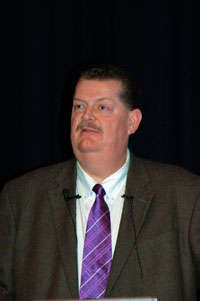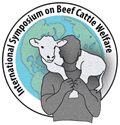Animal Welfare at the Beef Packing Level
Cargill Animal Protein uses remote video auditing system to evaluate and enforce animal welfare practices in its slaughter facilities.
MANHATTAN, Kan. (May 21, 2010) — Human behavior is almost as fascinating as animal behavior, according to Mike Siemens, an executive with Cargill Animal Protein. During the International Symposium on Beef Cattle Welfare, Siemens talked about what the meatpacking company has learned about its employees through the remote video auditing systems installed at beef slaughter plants. Some employees perform differently when they don’t realize they are on camera.

Mike Siemens emphasizes the need for commitment to animal welfare practices from the top down. Management must clarify expectations and respond appropriately to both compliance and noncompliance.
Siemens explained how Cargill works with a New York-based company to audit operations through video observation of unloading areas, crowding pens, restrainers and other points along each plant’s chain of operations. Particular attention is paid to all “critical” locations of cattle handling. If the third-party auditors see an event not in compliance with company protocol for animal welfare, Cargill management is notified. Supervisory personnel can then view the video and address noncompliance issues. Siemens said the feedback from video auditing helps the company improve its practices.
“We can identify potential handling issues and conduct trend analysis across plants,” Siemens explained. “It helps drive change, improves consistency and instills accountability.”
Siemens emphasized the need for commitment from the top down. Management must state clearly defined expectations and provide clear, consistent communication. Management must be consistent in responding to noncompliance and reward employees who meet or exceed expectations. Sharing results of audited performance across plants and between work shifts has created friendly competition to achieve high performance evaluations.
“In the future, I expect increased auditing requirements for all phases of (food animal) production and harvest,” Siemens stated. “The red meat supply chain needs to be confident in what it is doing. It needs to understand what is scientifically proven, but it also needs to understand societal concerns. With regard to animal welfare, we need to do things the way we say we do, and always try to improve.”
The beef cattle welfare symposium was conducted on campus at K-State University May 19-21. For additional presentation summaries, return to the Meetings > Other Industry Meetings > News Coverage page of the API Virtual Library. For more about the symposium and an archive to the 2008 symposium, visit www.isbcw.beefcattleinstitute.org.
Editor's Note: This article was written under contract or by staff of Angus Productions Inc. (API), which claims copyright to this article. It may not be published or distributed without the express permission of API. To request reprint permission and guidelines, contact Shauna Rose Hermel, editor, at 816-383-5270.

